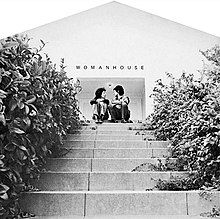art.wikisort.org - Künstler
Miriam Schapiro oder Shapiro (* 15. November 1923 in Toronto, Kanada; † 20. Juni 2015 in Hampton Bays, New York) war eine US-amerikanische Künstlerin kanadischer Herkunft. Sie war eine Pionierin im Bereich der Feministischen Kunst und Teilnehmerin an der künstlerischen Pattern-and-Decoration-Bewegung.
Leben und Werk
Miriam Schapiro war das einzige Kind russisch-jüdischer Eltern, Fannie Cohen (1899–1998) und Theodore Schapiro (1898–1999), deren Großeltern aus Russland emigriert waren.[1] Miriam Schapiro studierte an der University of Iowa, traf dort den Künstler Paul Brach (1924–2007), den sie 1946 heiratete.[2] Im Jahr 1951 zogen sie nach New York und schlossen Freundschaft mit vielen Künstlern der New York School, beispielsweise mit Joan Mitchell, Larry Rivers und Michael Goldberg. Während ihres Aufenthalts in New York in den 1950er und -60er Jahren hatte Schapiro eine erfolgreiche Karriere als Malerin im Stil des Abstrakten Expressionismus und speziell in der Form des Hard Edge.[3] 1955 wurde Sohn Peter geboren.

In den 1970er Jahren zog sie nach Kalifornien und begründete dort das „Feminist Art Program“ an dem California Institute of the Arts zusammen mit Judy Chicago. 1972 nahm sie an der gemeinsamen Ausstellung Womanhouse in Hollywood teil.
Schapiros Werk ab den 1970er Jahren besteht hauptsächlich aus Collagen, hergestellt aus einer Mischung von gemalten Teilen und Stoffen, die sie „femmages“ nennt. Ihr Essay Waste Not Want Not: An Inquiry into What Women Saved and Assembled − FEMMAGE, geschrieben 1977/78 mit Melissa Meyer, beschreibt „femmage“ als die Anwendung von Collage, Assemblage, Decoupage und Fotomontage in der Form, wie sie Frauen traditionell anwenden: beim Nähen, Schneiden, Applizieren, Kochen und dergleichen.[4] Im Jahr 1988 entstand eine Collage mit dem Porträt von Frida Kahlo.
1999 wurde Miriam Schapiro in New York zum Mitglied (NA) der National Academy of Design gewählt[5].
Schapiros Werke werden in zahlreichen Museen ausgestellt, beispielsweise in der National Gallery of Art in Washington, D.C. Ihre wichtige Rolle in der Kunst wurde 2002 mit der Verleihung des „Distinguished Artist Award for Lifetime Achievement“ der College Art Association, der nationalen amerikanischen Organisation der Künstler und Kunsthistoriker, deutlich.[6] Sie starb am 20. Juni 2015 im Alter von 91 Jahren in Hampton Bays, New York.[7]
Literatur
- Marika Herskovic, New York School Abstract Expressionists Artists Choice by Artists, (New York School Press, 2000.) ISBN 0-9677994-0-6
- Thalia Gouma-Peterson: Miriam Schapiro: shaping the fragments of art and life. Abrams, New York 1999, ISBN 0-810-94377-8
- Miriam Schapiro: The Education of Women as Artists: Project Womanhouse, Art Journal, vol. 31, no.3, Spring, 1972, S. 268–270
Weblinks und Quellen
- absolutearts.com: Miriam Schapiro (englisch)
- artcyclopedia.com: Miriam Schapiro (englisch)
- Womanhouse (englisch)
- jwa.org: Miriam Schapiro (englisch)
- Porträt von Frida Kahlo, 1988
Einzelnachweise
- Zitiert nach jwa.org
- Avital H. Bloch, Lauri Umansky, Impossible to Hold: Women and Culture in the 1960's, NYU Press, 2005, S. 319. ISBN 0-814-79910-8
- Fred S. Kleiner, Christin J. Mamiya, Helen Gardner, Gardner's Art Through the Ages, Thomson Wadsworth, 2005, S. 1073, ISBN 0-155-05090-7
- Kristine Stiles, Peter Selz, Theories and Documents of Contemporary Art: A Sourcebook of Artists' Writings, University of California Press, 1996, S. 151 ff. ISBN 0-520-20253-8
- nationalacademy.org: National Academicians "S" / Schapiro, Miriam, NA 1999 (Memento vom 15. Juli 2015 im Internet Archive) (abgerufen am 15. Juli 2015)
- Zitiert nach jwa.org
- William Grimes: Miriam Schapiro, 91, a Feminist Artist Who Harnessed Craft and Pattern, Dies. In: The New York Times vom 24. Juni 2015 (englisch, abgerufen am 25. Juni 2015).
| Personendaten | |
|---|---|
| NAME | Schapiro, Miriam |
| ALTERNATIVNAMEN | Shapiro, Miriam |
| KURZBESCHREIBUNG | feministische US-amerikanische Künstlerin und Autorin |
| GEBURTSDATUM | 15. November 1923 |
| GEBURTSORT | Toronto, Kanada |
| STERBEDATUM | 20. Juni 2015 |
| STERBEORT | Hampton Bays, New York |
На других языках
- [de] Miriam Schapiro
[en] Miriam Schapiro
Miriam Schapiro (also known as Mimi) (November 15, 1923 – June 20, 2015) was a Canadian-born artist based in the United States. She was a painter, sculptor, printmaker, and a pioneer of feminist art. She was also considered a leader of the Pattern and Decoration art movement.[1] Schapiro's artwork blurs the line between fine art and craft. She incorporated craft elements into her paintings due to their association with women and femininity. Schapiro's work touches on the issue of feminism and art: especially in the aspect of feminism in relation to abstract art. Schapiro honed in her domesticated craft work and was able to create work that stood amongst the rest of the high art. These works represent Schapiro's identity as an artist working in the center of contemporary abstraction and simultaneously as a feminist being challenged to represent women's "consciousness" through imagery.[2] She often used icons that are associated with women, such as hearts, floral decorations, geometric patterns, and the color pink. In the 1970s she made the hand fan, a typically small woman's object, heroic by painting it six feet by twelve feet.[3] "The fan-shaped canvas, a powerful icon, gave Schapiro the opportunity to experiment … Out of this emerged a surface of textured coloristic complexity and opulence that formed the basis of her new personal style. The kimono, fans, houses, and hearts were the form into which she repeatedly poured her feelings and desires, her anxieties, and hopes".[2][fr] Miriam Schapiro
Miriam Schapiro (née le 15 novembre 1923 à Toronto au Canada[1], et morte le 20 juin 2015[2]) est une artiste féministe canadienne ayant vécu aux États-Unis. Pionnière dans l'art féministe, elle utilisait différents médiums telle que la peinture, la sculpture et la gravure. Elle est considérée comme l'une des chefs de file du mouvement Pattern and Decoration[3].Другой контент может иметь иную лицензию. Перед использованием материалов сайта WikiSort.org внимательно изучите правила лицензирования конкретных элементов наполнения сайта.
WikiSort.org - проект по пересортировке и дополнению контента Википедии